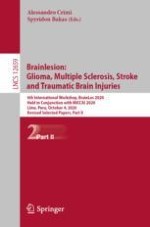2021 | OriginalPaper | Chapter
Memory Efficient 3D U-Net with Reversible Mobile Inverted Bottlenecks for Brain Tumor Segmentation
Authors : Mihir Pendse, Vithursan Thangarasa, Vitaliy Chiley, Ryan Holmdahl, Joel Hestness, Dennis DeCoste
Published in: Brainlesion: Glioma, Multiple Sclerosis, Stroke and Traumatic Brain Injuries
Publisher: Springer International Publishing
Activate our intelligent search to find suitable subject content or patents.
Select sections of text to find matching patents with Artificial Intelligence. powered by
Select sections of text to find additional relevant content using AI-assisted search. powered by
